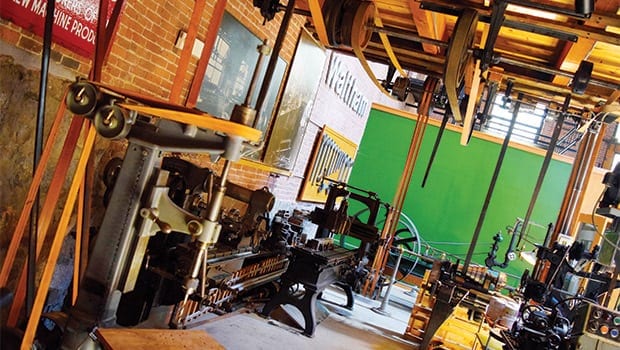The Charles River Museum of Industry and Innovation
Double duty as an arts venue

What do Rex Trailer’s “Boomtown,” “Sesame Street” and Monopoly have in common? The Charles River Museum of Industry and Innovation in Waltham, the Boston region’s new hot spot for the arts.
Located just west of Boston in the Francis Cabot Lowell Mill, the Charles River Museum is just a short walk from the MBTA Waltham commuter rail stop on the Fitchburg line. Its mission is to encourage and inspire future innovation in America through its collections and programs. The Museum explores the historical impact of industry on American culture and celebrates Waltham’s prominent role — including its reputation as the “Watch City” — in the rise of the American Industrial Revolution.

Author: Photo: Joe Niedbala/the Charles River Museum of Industry and InnovationA Amoskeag Steam Pumper fire engine.
Founded in 1813 as the Boston Manufacturing Company, Francis Cabot Lowell’s textile mill was America’s first integrated factory, and declared a National Historic Landmark in 1977. Mills of various kinds existed before, but the Boston Manufacturing Company was the first to combine all the steps of the production of a complex product under one roof.
It also was one of the first places in America where women, typically young farm or village girls, earned their own wages by operating the looms and other machinery. They worked and lived together and were expected to adhere to strict codes of conduct, while being exposed to wider educational opportunities and religious piety. Known as “Mill Girls,” they were free from parental authority but subject to corporate control exhibited by the men who served as overseers and keepers. On November 2, a “Mill Talk” lecture will explore the motivation and success of four female inventors, including Elizabeth Maggie, the woman behind the Monopoly game.
Today, thanks to the efforts of Waltham area community and business leaders, the Mill is home to a number of permanent exhibits celebrating both the Mill and Waltham’s history. With the arrival of a new leadership team in June 2015, including Bob Perry, new executive director, the museum took on new life as an arts venue.
A unique setting for performances, the open main floor can be viewed from the second floor mezzanine. Perry continues to work with various experts to curate dozens of events held throughout the year. Perry’s connections and his role as the lead organizer of the annual Watch City Steampunk Festival were helpful in expanding the Museum’s community.
One example of a current Museum arts program: the Waltham Film Factory, a collaborative educational project created to encourage and develop filmmaking skills in the community. The program kicked off September 21 with the first in a monthly series of paired screenings and filmmaking workshops. The first interactive screening was a documentary celebrating the 60th Anniversary of Rex Trailer and his beloved live television show, “Boomtown!” The evening’s program included discussions with Trailer’s family and co-workers and featured a guest appearance by Rex’s sidekick, Sgt. Billy, and Rex’s saddle. The screening, presented by the documentary’s producer and director Michael Bavaro, was followed by a Saturday filmmaking workshop on how to create your own biography and memories films.
The series also included an October screening and workshop by local filmmaking collective AgX on using traditional filmmaking media and techniques. On November 16 and 19, Waltham Film Factory will present both a screening and workshop on green screen “magic.” Green screens are a special effect technique commonly used in television and film, particularly Hollywood’s biggest blockbusters.
Another important offering is the Boiler House Jazz Series, curated by Ken Field. Field is a renowned saxophonist, flautist and composer. Since 1988 he has been a member of the internationally acclaimed modern music ensemble, Birdsongs of the Mesozoic, and has even composed pieces for “Sesame Street.” The Boiler House Jazz Series was created to demonstrate the wide stylistic and geographic diversity of that most American art form, and to present jazz that is a bit different from what many people imagine when they think of “jazz.” Other 2016 artists include the Fernando Brandão Trio; Ara Sarkissian & Musaner; and the Revolutionary Snake Ensemble. The Boiler House Jazz Series runs through December 4.
The 2nd SHIFT Music Series features live performances of musical “explorers and innovators.” Curated by legendary local musician and Waltham resident Michael Tarbox, the 2nd Shift Music Series is in the midst of its second season with a seven-show fall series and runs through December 8.
On November 4, the Museum features an evening of innovative dance by Jody Weber that explores our relationships with work via a conversation through dance between a modern professional woman and the 19th century Mill Girls. Weber Dance is a “contemporary dance company exploring the possibilities of the vast expanse of human expression revealed through the extraordinary dynamic nuance of the body in motion.”
“Bringing art and live performance to the Museum powerfully supports our mission,” said Perry. “The more we connect with new audiences, the more opportunities we have to develop active relationships with our community and educate people about how our collective industrial heritage affects us all.”
Disclosure: Bobbie Carlton was a longtime board member of the Charles River Museum of Industry & Innovation






